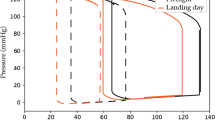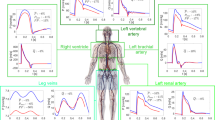Abstract
A significant fraction of astronauts experience postflight orthostatic intolerance (POI) during 10-min stand tests conducted on landing day. The average time that nonfinishers can stand is about 7 min. This phenomenon, including the delay in occurrence of presyncope, was studied with a five-compartment model of the cardiovascular system incorporating compartments for the heart/lungs, systemic arteries and cephalic, central, and caudal veins. The model included 28 independent parameters, including factors characterizing cardiac performance, vascular resistance, intrathoracic pressure, nonlinear venous compliance and circulating blood volume, and 13 dependent parameters, including cardiac output and cardiac and vascular compartment pressures and volumes. First, a sensitivity analysis of hemodynamic indicators of presyncope to independent parameters was performed. Results demonstrated that both cardiac output and arterial pressure were most sensitive to volume-related parameters, particularly total blood volume, and less sensitive to peripheral resistance. Next, a simulated postflight stand test confirmed that fluid loss due to capillary filtration, particularly from the caudal region where transmural pressure is high during standing, is a plausible mechanism of POI that also explains the delayed onset of symptoms in most astronauts. An accumulated drop in arterial pressure sufficient to compromise cerebral perfusion and, therefore, cause syncope was reached in about 7 min with a fluid loss of 280 mL. Finally, additional simulations showed that a 75% increase in peripheral resistance, similar to finishers of stand tests, was insufficient to overcome the loss of circulating fluid associated with capillary filtration, and extended the time that the modeled astronaut could stand by only about 1 min. It is therefore concluded that capillary filtration may play a key role in producing POI and that development of countermeasures should perhaps focus on reducing postflight capillary permeability or on stimulating volume-compensating mechanisms.



Similar content being viewed by others
References
Aratow M., Fortney S. M., Watenpaugh D. E., Crenshaw A. G., Hargens A. R. 1993 Transcapillary fluid responses to lower body negative pressure. J. Appl. Physiol. 74(6):2763–2770
Asmussen E., Christiansen E. H., Nielsen M. 1940 The regulatory circulation in different postures. Surgery 8:604
Baisch, F., L. Beck, G. Blomqvist, G. Wolfram, J. Drescher, J.-L. Rome, and C. Drummer. Cardiovascular response to lower body negative pressure stimulation before, during and after space flight. Eur. J. Clin. Invest. 30(12):1055–1065, 2000
Berry, C. A., and A. D. Catterson. Pre-Gemini medical predictions versus Gemini flight results. In: Gemini Summary Conference, Manned Spacecraft Center, Houston, TX, Feb 1–2, 1967, pp. 197–281 (NASA SP-138)
Blomqvist, C. G., and H. L. Stone. Cardiovascular adjustments to gravitational stress. In: Handbook of Physiology, Section 2, The Cardiovascular System, edited by J. T. Shepherd et al. Am Physiol Soc, 1982, pp. 1025–1063
Brown C. M., Hainsworth R. 1999 Assessment of capillary fluid shifts during orthostatic stress in normal subjects and subjects with orthostatic intolerance. Clin. Autonomic Res. 9(2):69–73
Boyers D. G., Cuthbertson J. G., Luetscher J. A. 1972 Simulation of the human cardiovascular system: a model with normal responses to change of posture, blood loss, transfusion and autonomic blockade. Simulation 18:197–206
Buckey J. C., Lane L. D., Levine B. D., Watenpaugh D. E., Wright S. J., Moore W. E., Gaffney F. A., Blomqvist C. G. 1996 Orthostatic intolerance after spaceflight. J. Appl. Physiol. 81(1):7–18
Charles J. B., Lathers C. M. 1991 Cardiovascular adaptation to spaceflight. J. Clin. Pharmacol. 31:1010–1023
Charles, J. B., M. W. Bungo, and G. W. Fortner. Cardiopulmonary Function. In: Space Physiology and Medicine, Chap 14, edited by A. E. Nicogossian, C. L. Huntoon, and S. L. Pool. Philadelphia, PA: Lea & Febiger, 1994
Ebert T. J., Smith J. J., Barney J. A., Merrill D. C., Smith G. K. 1986 The use of thoracic impedance for determining thoracic blood volume in man. Aviat. Space Environ. Med. 57:49
Evans J. M., Leonelli F. M., Ziegler M. G., McIntosh C. M., Patwardhan A. R., Ertl A. C., Kim C. S., Knapp C. F. 2001 Epinephrine, vasodilation and hemoconcentration in syncopal, healthy men and women. Autonom. Neurosci. 93:79–90
Finnerty F. A. Jr., Witkin L., Fazek J. F. 1954 Cerebral hemodynamics during cerebral ischemia induced by acute hypotension. J. Clin. Invest. 33: 1227
Fritsch-Yelle J. M., Charles J. B., Jones M. M., Breightol L. A., Eckberg D. L. 1994 Space flight alters autonomic regulation of arterial pressure in humans. J. Appl. Physiol. 77:1776–1783
Fritsch-Yelle J. M., Whitson P. A., Bondar R. L., Brown T. E. 1996 Subnormal norepinephrine release relates to presyncope in astronauts after spaceflight. J. Appl. Physiol. 81(5):2134–2141
Gauer O. N., Thron H. L. 1965 Postural change in the circulation. In: Hamilton W. F., Dow P. (Eds) Handbook of Physiology, Sect. 2, Circulation. Vol. 3, American Physiological Society, Washington, DC, p. 2409
Goldstein M. A., Edwards R. J., Schroeter J. P. 1992 Cardiac morphology after conditions of microgravity during Cosmos 2044. J. Appl. Physiol. 73(2 Suppl):94S–100S
Hagan R. D., Diaz F. J., Horvath S. M. 1978 Plasma volume changes with movement to the upright position. J. Appl. Physiol. 45:414
Heldt T., Shim E. B., Kamm R. D., Mark R. G. 2002 Computational model of cardiovascular response to orthostatic stress. J. Appl. Physiol. 92:1239–1254
Henry J. P., Gauer O., Kety S., Kramer K. 1951 Factors maintaining cerebral circulation during gravitational stress. J. Clin. Invest. 30:292–301
Hinghofer-Szalkay H., Kravik S. E., Greenleaf J. E. 1988 Effect of lower-body positive pressure on postural fluid shifts in men. Eur. J. Appl. Physiol. 57:48–54
Hinghofer-Szalkay H., Konig E. M., Sauseng-Fellegger G., Zambo-Polz C. 1992 Biphasic blood volume changes with lower body suction in humans. Am. J. Physiol. 263:H1270–H1275
Lanne T., Lundvall J. 1989 Very rapid net transcapillary fluid absorption from skeletal muscle and skin in man during pronounced hypovolaemic circulatory stress. Acta Physiol. Scand. 136:1–6
Lanne T., Edfeldt H., Lundvall J. 1989 Failure of the venous pressure decline in hypovolaemia to be transmitted to the capillary level and cause compensatory absorption of extravascular fluid into the circulation. Acta Physiol. Scand. 136:141–142
Lathers C. M., Charles J. B., Elton K. F., Holt T. A., Mukai C., Bennett B. S., Bungo M. W. 1989 Acute hemodynamic responses to weightlessness in humans. J. Clin. Pharmacol. 29:615–627
Leach C. S., Alfrey C. P., Suki W. N., Leonard J. I., Rambaut P. C., Inners D., Smith S. M., Lane H. W., Krauhs J. M. 1996 Regulation of body fluid compartments during short-term spaceflight. J. Appl. Physiol. 81(1):105–116
Louisy, F., D. Cauquil, C. Andre-Deshays, P. Schroiff, M. Lazerges, C. Lafaye, A. L. Camus, and G. Gallina. Air plethysmography: an alternative method for assessing peripheral circulatory adaptations during spaceflights. Eur. J. App. Physiol. 85(3–4):383–391, 2001
Mellander S. 1978 On the control of capillary fluid transfer by precapillary and postcapillary vascular adjustments. Microvasc. Res. 15:319–330
Pantalos, G. M., J. Mathias, M. K. Sharp, D. Watenpaugh, J. Buckey, S. Parnis, and A. Hargens. Variations in esophageal and abdominal pressure in humans during parabolic an space flight. In: Abstr. Aerospace. Med. Assoc., 1997
Ramsdell C. G., Mullen T. J., Sundby G. H., Rostoft S., Sheynberg N., Aljuri N., Maa M., Mukkamala R., Sherman D., Toska K., Yelle J., Bloomfield D., Williams G. H., Cohen R. J. 2001 Midodrine prevents orthostatic intolerance associated with simulated spaceflight. J. Appl. Physiol. 90:2245–2248
Shubrook S. J., Leverett S. D. 1973 Effect of the valsalva maneuver on tolerance to +Gz acceleration. J. Appl. Physiol. 34(4):460–466
Smith J. J. (ed) 1990 Circulatory Response to the Upright Posture. CRC Press, Boca Raton, FL
Thornton, W. E., and J. A. Rummel. Muscular deconditioning and its prevention in space flight. In: Biomedical Results from Skylab, edited by R. S. Johnston and L. F. Dietlein. Washington, DC: NASA, 1977, pp. 191–197 (SP-377)
Thornton, W. E., and G. W. Hoffler. Hemodynamic studies of the legs under weightlessness. In: Biomedical Results from Skylab, edited by R. S. Johnston and L. F. Dietlein. Washington, DC: NASA, 1977, pp. 324–329 (SP-377)
Watenpaugh, D. E., and A. R. Hargens. The cardiovascular system in microgravity. In: Handbook of Physiology-Environmental Physiology, Chap 29. New York: Oxford University Press, 1995
Waterfield R. L. 1931 The effects of posture on the circulating blood volume. J. Physiol. 72:1:110–120
Waters W. W., Ziegler M. G., Meck J. V. 2001 Postspaceflight orthostatic hypotension occurs mostly in women and is predicted by low vascular resistance. J. Appl. Physiol. 92:586–594
White R. J., Blomqvist C. G. 1998 Central venous pressure and cardiac function during spaceflight. J. Appl. Physiol. 85(2):738–476
Author information
Authors and Affiliations
Corresponding author
Rights and permissions
About this article
Cite this article
Broskey, J., Sharp, M.K. Evaluation of Mechanisms of Postflight Orthostatic Intolerance with a Simple Cardiovascular System Model. Ann Biomed Eng 35, 1800–1811 (2007). https://doi.org/10.1007/s10439-007-9341-7
Received:
Accepted:
Published:
Issue Date:
DOI: https://doi.org/10.1007/s10439-007-9341-7




